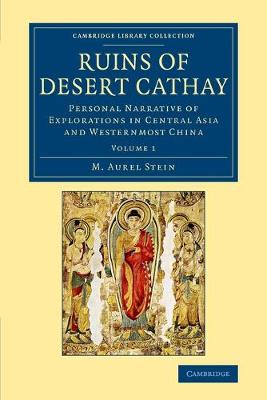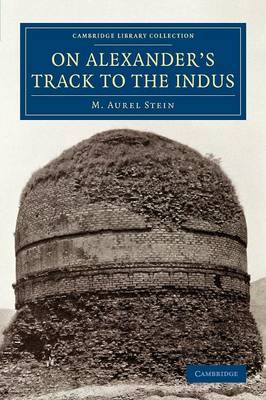Cambridge Library Collection - Archaeology
1 primary work • 6 total works
Volume 1
In this two-volume work, published in 1912, the Hungarian-born archaeologist Marc Aurel Stein (1862–1943) describes his second expedition to the deserts of Chinese Turkestan in 1906–8. (His account of his first expedition, Sand-Buried Ruins of Khotan (1903), is also reissued in this series.) Stein intended this account to be read by non-specialists, and, like his previous book, it is highly illustrated and full of interesting details about his journey and the people he met en route, as well as of the important archaeological discoveries which still link his name with the civilisation of this remote and dangerous area. In Volume 1, Stein describes the problems of setting up the expedition and the excitement and perils of the route, which took him through the tribal areas of the North-West Frontier and the kingdom of Afghanistan, ending with his arrival at the western extremity of the Great Wall of China.
In this two-volume work, published in 1912, the Hungarian-born archaeologist Marc Aurel Stein (1862-1943) describes his second expedition to the deserts of Chinese Turkestan in 1906-8. (His account of his first expedition, Sand-Buried Ruins of Khotan (1903), is also reissued in this series.) Stein intended this account to be read by non-specialists, and, like his previous book, it is highly illustrated and full of interesting details about his journey and the people he met en route, as well as of the important archaeological discoveries which still link his name with the civilisation of this remote and dangerous area. As well as locating the western extremity of the Great Wall of China, Stein discovered the caves near the great trading post of Dunhuang which contained - walled up and almost perfectly preserved - manuscripts, sculptures, painted silks and other materials hidden by Buddhist monks nine hundred years previously.
The Hungarian-born archaeologist Marc Aurel Stein (1862–1943) is probably best remembered today for his explorations in Chinese Turkestan, and especially his discovery of the Buddhist treasure of Dunhuang, described in his earlier works, Sand-Buried Ruins of Khotan and Ruins of Desert Cathay (also reissued in this series). Stein was equally interested in the territory north-west of the North-West Frontier, and in this highly illustrated 1929 work he describes an expedition to survey the route of Alexander the Great's invasion of India in 326 BCE. Having long been intrigued by 'that comparatively small area to the west of the Indus which Alexander's march of conquest towards India for a brief span of time illuminates as it were with the light of a meteor', and by archaeological remains showing a blend of Hellenistic and Buddhist art, Stein offers a fascinating account of an ancient clash of civilisations.
Between 1900 and 1901, the Hungarian-born archaeologist Marc Aurel Stein (1862–1943) made the first of several significant trips through Central Asia. In 1903, he published this account of his journey from Calcutta to London via the deserts of Chinese Turkestan. The text is richly illustrated with photographs of locations on the route followed by Stein's party, as well as of the people they encountered and many of the artefacts they excavated in the vicinity of the ancient oasis town of Khotan. Stein intended his book to be accessible to non-specialists, and his descriptions of the many important archaeological discoveries, such as Sanskrit texts of Buddhist scriptures, are interspersed with compelling human details and anecdotes about traversing the challenging terrain of eastern Central Asia. The work of an indefatigable explorer, this book sheds light on the spread of Graeco-Buddhist culture along the Silk Route.
In this two-volume work, published in 1912, the Hungarian-born archaeologist Marc Aurel Stein (1862–1943) describes his second expedition to the deserts of Chinese Turkestan in 1906–8. (His account of his first expedition, Sand-Buried Ruins of Khotan (1903), is also reissued in this series.) Stein intended this account to be read by non-specialists, and, like his previous book, it is highly illustrated and full of interesting details about his journey and the people he met en route, as well as of the important archaeological discoveries which still link his name with the civilisation of this remote and dangerous area. In Volume 1, Stein describes the problems of setting up the expedition and the excitement and perils of the route, which took him through the tribal areas of the North-West Frontier and the kingdom of Afghanistan, ending with his arrival at the western extremity of the Great Wall of China.
In this two-volume work, published in 1912, the Hungarian-born archaeologist Marc Aurel Stein (1862–1943) describes his second expedition to the deserts of Chinese Turkestan in 1906–8. (His account of his first expedition, Sand-Buried Ruins of Khotan (1903), is also reissued in this series.) Stein intended this account to be read by non-specialists, and, like his previous book, it is highly illustrated and full of interesting details about his journey and the people he met en route, as well as of the important archaeological discoveries which still link his name with the civilisation of this remote and dangerous area. In Volume 2, Stein describes the discovery of the caves near the great trading post of Dunhuang which contained - walled up and almost perfectly preserved - manuscripts, sculptures, silk cloths, and the Diamond Sutra, the earliest complete and dated example of a printed book, hidden by Buddhist monks nine hundred years previously.


